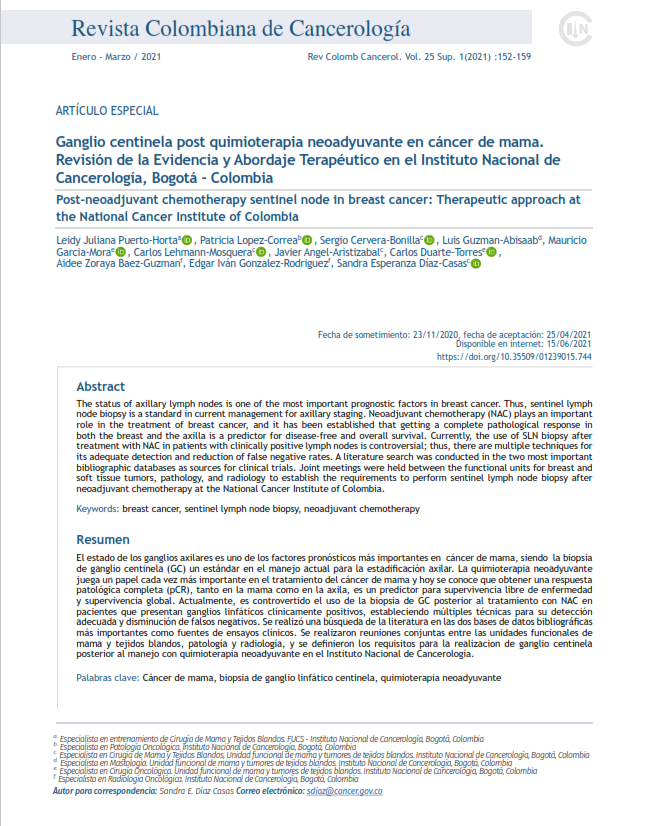Ganglio centinela post quimioterapia neoadyuvante en cáncer de mama. Revisión de la Evidencia y Abordaje Terapéutico en el Instituto Nacional de Cancerología, Bogotá - Colombia
DOI:
https://doi.org/10.35509/01239015.744Palabras clave:
Cáncer de mama, biopsia de ganglio linfático centinela, quimioterapia neoadyuvanteResumen
El estado de los ganglios axilares es uno de los factores pronósticos más importantes en cáncer de mama, siendo la biopsia de ganglio centinela (GC) un estándar en el manejo actual para la estadificación axilar. La quimioterapia neoadyuvante juega un papel cada vez más importante en el tratamiento del cáncer de mama y hoy se conoce que obtener una respuesta patológica completa (pCR), tanto en la mama como en la axila, es un predictor para supervivencia libre de enfermedad y supervivencia global. Actualmente, es controvertido el uso de la biopsia de GC posterior al tratamiento con NAC en pacientes que presentan ganglios linfáticos clínicamente positivos, estableciendo múltiples técnicas para su detección adecuada y disminución de falsos negativos. Se realizó una búsqueda de la literatura en las dos bases de datos bibliográficas más importantes como fuentes de ensayos clínicos. Se realizaron reuniones conjuntas entre las unidades funcionales de mama y tejidos blandos, patología y radiología, y se definieron los requisitos para la realizacion de ganglio centinela posterior al manejo con quimioterapia neoadyuvante en el Instituto Nacional de Cancerología.
Referencias bibliográficas
Veronesi U, Galimberti V, Mariani L, Gatti G, Paganelli G, Viale G, et al. Sentinel node biopsy in breast cancer: Early results in 953 patients with negative sentinel node biopsy and no axillary dissection. Eur J Cancer. 2005;41(2):231–7. https://doi.org/10.1016/j.ejca.2004.05.009
Krag DN, Anderson SJ, Julian TB, Brown AM, Harlow SP, Costantino JP, et al. Sentinel-lymph-node resection compared with conventional axillary-lymph-node dissection in clinically node-negative patients with breast cancer: Overall survival findings from the NSABP B-32 randomised phase 3 trial. Lancet Oncol. 2010;11(10):927–33. https://doi.org/10.1016/S14702045(10)70207-2
Mansel RE, Fallowfield L, Kissin M, Goyal A, Newcombe RG, Dixon JM, et al. Randomized multicenter trial of sentinel node biopsy versus standard axillary treatment in operable breast cancer: The ALMANAC trial. J Natl Cancer Inst. 2006;98(9):599–609. https://doi.org/10.1093/jnci/djj158
Giuliano AE, Hunt KK, Ballman K V., Beitsch PD, Whitworth PW, Blumencranz PW, et al. Axillary dissection vs no axillary dissection in women with invasive breast cancer and sentinel node metastasis: A randomized clinical trial. JAMA - J Am Med Assoc. 2011;305(6):569–75. https://doi.org/ 10.1001/jama.2011.90
Galimberti V, Cole BF, Zurrida S, Viale G, Luini A, Veronesi P, et al. Axillary dissection versus no axillary dissection in patients with sentinel-node micrometastases (IBCSG 23-01): A phase 3 randomised controlled trial. Lancet Oncol. 2013;14(4):297–305.https://doi.org/10.1016/S1470-2045(13)70035-4
Donker M, van Tienhoven G, Straver ME, Meijnen P, van de Velde CJH, Mansel RE, et al. Radiotherapy or surgery of the axilla after a positive sentinel node in breast cancer (EORTC 1098122023 AMAROS): A randomised, multicentre, open-label, phase 3 non-inferiority trial. Lancet Oncol. 2014;15(12):1303–10. https://doi.org/10.1016/S1470-2045(14)70460-7
Cortazar P, Zhang L, Untch M, Mehta K, Costantino JP, Wolmark N, et al. Pathological complete response and long-term clinical benefit in breast cancer: The CTNeoBC pooled analysis. Lancet. 2014;384(9938):164–72. https://doi.org/10.1016/S01406736(13)62422-8
Díaz-Casas SE, Castilla-Tarra JA, Pena-Torres E, Orozco-Ospino M, Mendoza-Diaz S, Nuñez-Lemus M, et al. Pathological Response to Neoadjuvant Chemotherapy and the Molecular Classification of Locally Advanced Breast Cancer in a Latin American Cohort. Oncologist. 2019;24(12):1–11. https://doi.org/10.1634/theoncologist.2019-0300
MINSALUD INC COLCIENCIAS. Guia de práctica clínica Cáncer de seno. 2013;40–100. Available from: www.minsalud.gov.co
Kim T, Giuliano AE, Lyman GH. Lymphatic mapping and sentinel lymph node biopsy in early-stage breast carcinoma: A metaanalysis. Cancer. 2006;106(1):4–16. https://doi.org/10.1002/cncr.21568
Fisher B, Brown A, Mamounas E, Wieand S, Robidoux A, Margolese RG, et al. Effect of preoperative chemotherapy on local-regional disease in women with operable breast cancer: Findings from national surgical adjuvant breast and bowel project B-18. J Clin Oncol. 1997;15(7):2483–93. https://doi.org/ 10.1200/JCO.1997.15.7.2483
Kuehn T, Bauerfeind I, Fehm T, Fleige B, Hausschild M, Helms G, et al. Sentinel-lymph-node biopsy in patients with breast cancer before and after neoadjuvant chemotherapy (SENTINA): A prospective, multicentre cohort study. Lancet Oncol [Internet]. 2013;14(7):609–18. Available from: http://dx.doi.org/10.1016/S1470-2045(13)70166-9 https://doi.org/10.1016/S1470-2045(13)70166-9
Boughey JC, Suman VJ, Mittendorf EA, Ahrendt GM, Wilke LG, Taback B, et al. Sentinel lymph node surgery after neoadjuvant chemotherapy in patients with node-positive breast cancer: The ACOSOG Z1071 (alliance) clinical trial. JAMA -J Am Med Assoc. 2013;310(14):1455–61. https://doi.org/10.1001/jama.2013.278932
Boileau JF, Poirier B, Basik M, Holloway CMB, Gaboury L, Sideris L, et al. Sentinel node biopsy after neoadjuvant chemotherapy in biopsy-proven node-positive breast cancer: The SN FNAC study. J Clin Oncol. 2015;33(3):258–63. https://doi.org/10.1200/JCO.2014.55.7827
Classe JM, Loaec C, Gimbergues P, Alran S, de Lara CT, Dupre PF, et al. Sentinel lymph node biopsy without axillary lymphadenectomy after neoadjuvant chemotherapy is accurate and safe for selected patients: the GANEA 2 study. Breast Cancer Res Treat [Internet]. 2019;173(2):343–52. Available from: http://dx.doi.org/10.1007/s10549-018-5004-7 https://doi.org/ 10.1007/s10549-018-5004-7
El H, Chehade H, Headon H, Tokhy O El, Heeney J. AC. https://doi.org/ 10.1016/j.amjsurg.2016.07.018
Caudle AS, Yang WT, Krishnamurthy S, Mittendorf EA, Black DM, Gilcrease MZ, et al. Improved axillary evaluation following neoadjuvant therapy for patientswith nodepositive breast cancer using selective evaluation of clipped nodes: Implementation of targeted axillary dissection. J Clin Oncol. 2016;34(10):1072–8. https://doi.org/10.1200/JCO.2015.64.0094
Cómo citar
Descargas

Descargas
Publicado
Número
Sección
Licencia
Todos los derechos reservados.




